Small Business Credit Insights

Identity Fraud in Commercial Applications We recently sat down with two Experian experts to talk about commercial fraud trends and gain an understanding of why commercial fraud is on the rise, and what organizations can do to combat the problem while at the same time grant credit to growing businesses. What follows is a lightly edited transcript of our interview. Watch Our Business Chat Interview Subscribe To Our YouTube Channel What follows is a lightly edited transcript of our conversation. [Gary]: Hello and welcome to Business Chat I'm Gary Stockton with Experian Business Information Services, and today we're going to talk about Commercial Entity Fraud with two of our experts. [Gary]: Patricio HernandezBarron is a Product Marketing Manager here in Business Information Services, and he covers the commercial fraud space. Chris Gerding is a Consultant and he also focuses on commercial fraud. Welcome to business chat guys. [Gary]: The two of you recently collaborated on a perspective paper called Identity Fraud in Commercial Applications, and the piece asserts that there's been rapid growth in commercial fraud in the past few years. So, Patricio, if I could ask you, how are B2B companies affected compared to business to consumer companies in battling fraud? [Patricio]: Let me start by saying that both commercial and consumer or B2B or B2C companies are both affected by fraud, whether this is first-party fraud, third-party fraud, or synthetic fraud. They're both affected. Now, where it becomes different is the type of solutions that are out there in the market for them to solve it. There have been a lot more advancements on the consumer front, and it makes sense, consumer trends move a lot quicker compared to the commercial side of things. [Patricio]: But, in 2020, it's been considerably harder for fraudsters to get through the filters on the consumer side. So (fraudsters) being smart, they've started to focus on the commercial lines of business, which they already know that they're a little behind in terms of the sophistication of consumer lines. So, it's opened a potential opportunity gap for fraudsters to get through and businesses can't wait any longer. They need to raise their game and make that parity between consumer and commercial lines of business in terms of the fraud mitigation strategies. [Gary]: What's the scale and size of the problem of commercial fraud? [Patricio]: It's a big problem. A recent report published by the Association of Certified Fraud Examiners stated that 5% of business revenue was lost to fraud. 55% of respondents we asked said that as of 2019 fraud attacks have increased. So there's a clear problem right now, whether these businesses are recognizing these losses as bad credit or as fraud losses, that is the first thing that they need to focus on. [Patricio]: And the thing is, many of our customers would tell us, “we don't have a fraud problem”, but it was because they weren't recognizing and discerning between credit losses and fraud attacks. So that is the first thing that they need to focus on, start differentiating and categorizing those losses differently so they can start looking into it. The other thing that I'm sharing around this topic is many times businesses tighten their credit decisioning in hopes to reduce those losses. But that was counter-intuitive because they were making it harder for potentially genuine customers to make it through the application process. And yes, the fraudsters were passing this filter or no filters but were passing this credit scoring with no problem because they knew the data that would be required, and there were again, no fraud filters in place to stop them. [Gary]: So, Chris, can you talk about some typical scenarios in which businesses, especially small businesses are typically attacked by fraudsters? [Chris]: Small businesses and any business have a lot in common with consumers. There are modes and fraud scenarios where both are vulnerable. And businesses typically have both financial assets and competitive information at risk. They could be phished; they could be socially engineered, and this is exactly what we read on a consumer basis when we hear about how to avoid fraud. [Chris]: Second, leakage of sensitive information over the other channels can result in direct fraud, like account numbers, pins, obvious targets. However, they need to misrepresent their identity in many cases. And the contact information such as the firm name, the address, the owners, or officer's personal details, this kind of information when compromised leads to potentially bigger and harder to detect, harder to stop fraud schemes. Consumers can be defrauded like businesses, but these are the more big-ticket business-specific categories that you're seeing here on this slide. [Chris]: These three represent a good slice of the many ways businesses are defrauded and small businesses with some vulnerabilities associated with not having millions and millions to spend on fraud defenses would be vulnerable to some extent. The equipment financing and leasing firms can be defrauded either out of funds or especially vehicles and heavy equipment. We see cases not many in the news, but you do hear about these, where, if you pass the finance companies fraud screen, fraudsters can successfully apply for financing and potentially come away with, I mean, a car would be on the low end of this, construction equipment for or combined for major capital items. Then they disappear. [Chris]: Number two, fake invoices are a very easy way comparably to collect perhaps smaller amounts, but these can be forged documents sent in under the wire and they are paid sometimes by very busy accounts payable people with very few defenses in place, and something that we're going to talk about later, fraud payments figure very largely in commercial fraud. Payments that are not backed up by good funds and intentionally sent it to cover a balance on an account are a very big part of commercial fraud. Fraudsters may actually make multiple payments, playing the timing game so they keep the account and the account balance alive and growing, or the credit balance on the account so that they can perhaps get more from the fraudulent credit relationship that they've built than the intended credit line by this timing and submission of payments. They can do this for several industries. They can do this for all different kinds of payment items themselves. They could be done with forged paper checks, electronic payments, and sometimes counterfeit payments themselves. [Gary]: Patricio, turning to you, would profit be impacted by implementing fraud prevention filters? I would imagine that would hinder some profitable growth? [Patricio]: It's a tricky one because, you know, there's this big misconception that by applying fraud filters, that's going to affect your profit or affect your number of applications going through. And it is true to an extent by applying fraud filters, you will see fewer applications going through. But affecting your profit, it's the complete opposite. It's actually going to reduce the losses that you'll be incurring, and I briefly touched upon this in your previous question, but what many companies do when they're not able to differentiate between credit losses and fraud losses, they tighten their decisioning in their credit applications. Those potentially good customers don't make it through, but fraudsters make it through with no problem at all. Because the decisioning system that they have for credit purposes does not do much for mitigating the fraudsters. [Patricio]: Many times, these companies don't invest in fraud solutions until they've gotten this big hit from a fraud attack, at that point, it's already too late. So, I would say that the best thing to do to help your profit is to be proactive because fraud can affect your profit if you get impacted. If you're proactive about it, you can protect or reduce those fraud losses that you're currently seeing as overall fraud, or losses that could be a fraud and not just credit losses. [Gary]: What's the number one step that commercial business, especially a small business can take to combat this wave of commercial fraud? [Chris]: Awareness must be built into the culture and it must be built into the solution and how the firm deals with the solution because there's no way to solve the fraud problem with a turnkey black box, turn it on, and forget it, we don't have that. And we may not have that for many, many years. [Gary]: Can you tell me more about the first payment defaults and how lenders are addressing that problem? [Chris]: We spoke a bit about payments in general as a fraud channel, but this is a particularly aggressive form of fraud or credit abuse. And it happens when the borrowing party just never ever makes one payment on the account. They may utilize the entire credit line and they just don't ever pay. So when the first payment is in default, there's a high suspicion that this could be a fraudster. There's a little ambiguity, as I said, but the credit and the fraud dimensions are rather close. They're rather parallel, in terms of how they are dealt with. [Chris]: What are we doing about accounts that are very brazen and do this on the first payment due? We evaluate the risk at the time of enrollment. This is very important, we don't know, who's not going to pay us the first time. So we need a tool that evaluates, in this case, we offer a score, a commercial first payment default score, which is very high performance and very friendly to the combined mix of consumer and commercial data that a firm might have. Second, it pays to look at the risk of the entire portfolio for first payment default periodically. Again, is done with a score, it could be the same score I mentioned. In the third category, if it's necessary, the host firm may wish to use scoring the individual payment item, the check, the online payment as a fraud evaluation, which is done by a different set of scores to manually perform systemic checks. [Gary]: So Patricio what are some of the most common misunderstandings in fraud prevention products? [Patricio]: Fraud filters will affect the number of applications that you are able to approve. As we mentioned before, it does affect the number of applications that you'll see come through, but it will help increase your profit by incurring fewer losses. Again, fewer fraudsters make it through equals fewer losses coming into your system. The second one would be that most fraud can be solved by verifying the identity of the user. And sure, it's because third-party fraud solutions are very popular, but that's not going to help you with all types of fraud. That's why you do need a layered approach for mitigating what's going to come through the door because, at the end of the day, you don't know what type of fraud you're going to be seeing. [Patricio]: By implementing a solution that will verify the identity of the user, that's not going to help you fight all types of fraud. In fact, stand-alone, you will do very little to mitigate first-party fraud and likewise with synthetic fraud. So again, if the way to solve fraud is not with a one size fits all approach, it's layered whether you have the resources and the capacity to implement a geolocation verification, or verify the validity of the data or verify the identity of the business owner. These are all things that are just going to prevent and help you weed out the different types of application fraud that you could see (coming) through the door. [Gary]: Chris, what can small businesses do to engage with Experian and minimize their fraud exposure? [Chris]: We love to talk, especially to small businesses on a very global scale in terms of their business operations and where it is that we might be able to help them. They may come to us with a great deal of awareness that they have a fraud problem and they kind of know where it is, but they look for a specific solution. Other small businesses may come to us with general concern. And in those, and in other cases, we are happy to sit down with them and do what I would call a free consultation and look at their information and make some suggestions. [Chris]: What we do is we offer solutions, but we like to add to that the knowledge of the particular client's situation, so that they become wiser and they become enabled by the kind of services that we provide, and they become enabled by the information we can bring to them upfront so they can make a wise consumer solution as it were. [Gary]: Well fraud in the payment protection program or the PPP program is all over the news. What do you make of that? Are these fraudulent applications affecting lenders, even though the losses would be absorbed by the government? [Patricio]: While many of these lenders know and think that the loss of the potential losses would be absorbed by the government, the reality is that it's uncovering many gaps for these lenders. First, we understand there's a greater volume of applications going through their systems. So what many of these lenders have done is either turn off, completely turn off their fraud mitigation systems, or they've reduced the amount of vetting that they do, because they're not too worried because they know that the government is going to absorb those losses because of the volume of applications that they see. Now, the problem with that is that if they completely turned off the system, now they have potential fraudsters within their portfolio, or on the other hand, if they lessened the amount of filtering that they do, and yet still some fraudsters make it through, it's going to be very hard to weed out those fraudsters down the line. It's just putting more risk to your overall portfolio, and, people, once they're in there, they've already uncovered some gaps in your underwriting process. So again, just down the line is going to be very hard to weed out these fraudsters that made it through your portfolio, [Gary]: Chris, anything to add? [Chris]: That was a good summary. I would add only that the other side of the coin is when you put many, many tens of millions of good Government money into the hands of fraudsters, you're sort of inflating the entire credit system. You're allowing bad people to get what appears to be credit for good loans until they're discovered. Many of these will probably not be discovered. So you're kind of adding bads to the system and calling them goods. And that's never good for all of us. [Gary]: Well, this has been very helpful guys. I want to say thank you very much for coming on Business Chat and sharing your insights. Related Posts
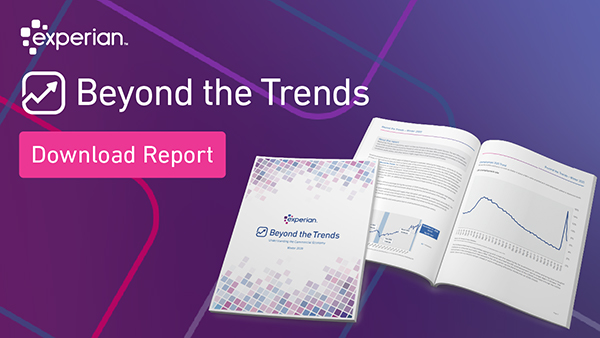
Beyond the Trends Spring 2021 - now available We're excited to announce the release of our second Beyond the Trends report. This report's going to deep dive into the economic trends that we're seeing in the market now. We look at some commercial and consumer credit trends that will impact recovery. And we'll deep dive into some of the industries that are most impacted. One of the things we talk about in this edition is economic growth. As excitement builds within the markets and reopening continues across different regions, we see an expectation for 7% GDP growth in the U.S. We're seeing a 27% increase in business starts year-over-year, and businesses reopened. We have new businesses emerging as well. In this report, we'll look at ways that lenders, as well as businesses, will be seen in credit markets and how growth can occur. Finally, with new stimulus in the market, consumers are ready to spend. Small businesses will look for opportunities to move from security mode and safety mode, business preservation into a transformational growth mode. Stay informed by downloading your copy of the Beyond the Trends report. Download the latest report
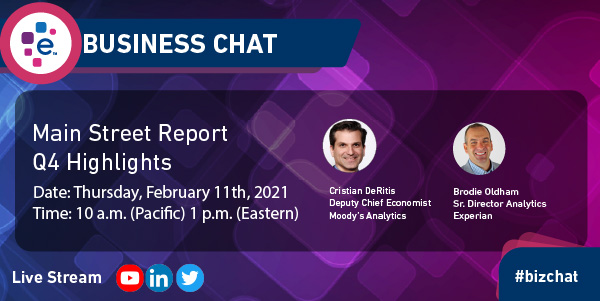
Main Street Report Q4 Highlights - Business Chat In this post we include a transcript from our February 11th Business Chat about the highlights in the most recent Main Street Report for Q4, 2020. We were joined by Cristian DeRitis, Deputy Chief Economist from Moody's Analytics, and Brodie Oldham, Senior Director of Analytics for Experian. [Gary]: Welcome to Business Chat. We're going to be talking about small business credit today—small business credit trends for Q4 with the release of the Experian Moody's Analytics Main Street Report. We've got the Deputy Chief Economist of Moody's Analytics, Christian DeRitis with us. Good morning, Christian. [Cristian]: Hi, good morning [Gary]: Good morning. [Gary]: And joining Christian is Brodie Oldham. He's a Senior Director of Analytics here at Experian. [Brodie]: Good morning. [Gary]: So glad you guys could join us today. So we're going to be taking a, look at the the highlights from the Experian Moody's Analytics Main Street Report just released. The report had three real standout items for me - the increase in hiring during Q4 that would be normally be expected. Delinquency rates declining to 1.21% and taxes as a main concern. We're showing that small businesses did add employees in Q4. It looks like those jobs appear to be funded primarily through credit. And businesses did keep the outstanding balances in check in Q4 with that moderate delinquency edging down to 1.21%, this time last year, it was around 1.60%. So, you know, there some good things there in the report, it seems kind of counter-intuitive, you know, when you read the headlines, but one of the things that also is starting to kind of resurge as a concern among business owners are taxes related to maybe a new administration and having things taking a different direction in terms of taxation. S. The thing that is probably on the minds of most small business owners and the nation really would be stimulus and getting some help for business owners. Biden has proposed a $1.9 trillion relief package. So Christian, I wanted to get your thoughts on the package, and if you could maybe cover some of the high points on it and what your thoughts are. [Cristian]: Yeah, sure. So they, you know, the $1.9 trillion package is an extension, if you will, of the cares act that we had last year or two, $2.4 trillion package, plus the additional stimulus that was passed at the end of December, really the purpose of those packages to my mind, it was largely preservation, right? We had households, small businesses that were really struggling under the weight of the pandemic and the associated closures. And so that assistance was really the lifeline to keep household finances in intact to some degree and to, and to preserve small businesses. Right? Last thing we wanted is to have millions of businesses failing. And then even when we get to the recovery stage, we don't have any, any of that, uh, that foundation to build off of the next, stimulus here. The 1.9 trillion that's been proposed, I think this package or some version of it is really intended to be stimulative to go to the next level where we have the vaccines kicking in the economy is recovering. You have consumers of being a little bit more positive and hopeful of the future here. And this package to me, is really designed to jumpstart some of the activity to ensure that we build some momentum and keep going in particular for small businesses. We have extension of the PPP program. That's the Paycheck Protection Program, this time around monies allocated are designed to be much more focused on the truly smallest businesses, many of which have been struggling and have few other options when it comes to credit. And so, I view that certainly as a positive as we, again, look forward to the future here, in terms of consumers coming back in leisure hospitality spending, coming back as people start to feel more comfortable after the vaccination efforts take hold. And so this, I, I do believe that this stimulus is certainly beneficial to ensure that we, we make it to that a more positive growth environment towards the end of the year, say the third or fourth quarter, I don't know that the full $1.9 trillion package will actually be passed. There's certainly a lot of debate around it, but I think some version of it that perhaps a scale-down package, maybe something closer to a trillion dollars will be passing that that certainly will be helpful for households and small businesses alike. [Gary]: Very good. Alright. Turning to you Brodie. One of the things that we saw again in the report would be credit and use of credit and businesses had kind of their appetite for credit in the Q4 timeframe had kind of declined. Did you have a comment on that? [Brodie]: I do, and, you know, it is a trend that we've been seeing through the summer. That pull back when we look at small businesses, just prior to the pandemic, what we saw them do is open up credit, looking for some longer term credit facilities that they could, uh, reach into and create some cushion for them as they looked forward and saw the pandemic growing, knowing that we would be entering some type of recessionary period. They knew that lenders would tighten up criteria as they went forward. And lenders did turn on their recessionary underwriting programs toward the beginning of last summer. And that really created a gap there for funding for small businesses and for their survival. Like Christian spoke to about stimulus, came in and provided some of that low cost alternative funding that small businesses might have gotten otherwise from banks or credit unions Fintechs across the marketplace. And so when we looked at that stimulus coming out, it really added or exacerbated that pull back that we saw of small businesses reaching out for this type of credit. Now we had the first round of stimulus that went really to all businesses, across the spectrum. When we look at the second poll, that's going to come out the second round of stimulus, that'll be part of the market what we're going to see is, and we're seeing already, a large number of those that were in the first round of PPP loans are entering the second round up to 93%. We've seen eighties, seventies across some of our different lenders. You know, at the second round is going to require some additional look at how a business's performance was through the third and fourth quarter if they have losses and, you know, those that picked it up in the first round, not all really needed it. And they took it from the perspective of we're going to take in the money. We're going to pay down some of our loans. We're going to, create some additional utilization space for us. And we saw some of that across the trends. And we'll talk about some of that in the upcoming Quarterly Business Credit Review. But what we're going to see as we go forward, is that, you know, as the pandemic lightens a bit, we see the vaccines take hold. We're going to see that some of the collections and foreclosure activity is going to slow a bit. We're going to see, you know, we're going to see those moratoriums come to an end. What that's going to create is a need for, some additional credit. And some of that's going to be beyond what will be provided in the stimulus packages. And so, as we go forward, as the market opens up, we see more foot traffic, businesses are going to go from that survival feel, into more of a future investment type of a growth feel. And in that they're going to be looking for banks and credit unions and fintechs and across the marketplace to again, look for opportunities to pick up some additional funding as we go forward. [Gary]: Very good. So gentlemen, you know, we're in Q1 right now, we should be seeing data for that coming in the early part of April, any thoughts on how this is going to break in terms of credit performance, business performance, if I guess it all depends on stimulus right now, and we've got what's happening in Texas and other things that are complicating things, any thoughts to, to close with? [Cristian]: Yeah. So from my perspective, I think it's still going to be a Rocky few months here. Assuming that stimulus does kick in and we continued to provide support to households and small businesses, I would expect the credit performance actually is going to remain fairly strong in the short term. And it's really, once we move beyond and remove those supports in the third, fourth quarter, we're going to have some counteracting forces, we'll have a stronger economy, so growth and labor market's coming back. Revenues are rising at a, at businesses. On the other hand, those supports are going away. There's a threat of somewhat higher interest rates. And so that I do expect to see a wave of bankruptcies and some additional delinquencies rising. But I don't, I don't expect that we're going to see a, a substantial shock. I think it's some more return to normality, the delinquencies and default rates are perhaps artificially suppressed for now. And they'll just gradually rise back to more normal level, but I don't know, Brodie, maybe you have a different opinion? [Brodie]: No, I think you're right on Christian. I think what we'll also see is you know, more new businesses entering the market. We saw a lot of closures that came toward the end of last year. We're going to see more reopenings, but those new businesses that are opening are going to have a hard time building credit as we come forward. They're not going to have that credit history that some of these that closed did. We'll see them start to build that credit history. We're going to see lenders some use different tools to differentiate credit risk for some of these new businesses and remarket. So we'll see originations begin to rise. We'll see some of that underwriting criteria loosen even continue to loosen into the first and second quarter. So it's going to give more opportunity for small businesses. Certainly as we get into the summertime, as, you know, foot traffic is going to increase, we're really going to be in a better place as a country. So I think we're going to really have an opportunity for businesses again, to go from that survival mode into what's my future, going to look like how do I invest to grow from here? [Gary]: Very good. Well, we'll be getting together again on March 16th. We're going to be doing more of a deep dive on the Experian Moody's Analytics Main Street Report, and that'll be the report for the Q4, Derek Grunfelder-McCrank is going to be joining us. That's Christian's colleague. And so I will see you gentlemen again on the 16th. And folks, if you would like to attend a webinar, there's a link here in this slide and also I will leave a link in the description for this video and a link to the report. If you haven't got your copy, please sign up. We'd love to get that report out there, have more people read it. Thanks very much for coming to Business Chat today. Thank you.
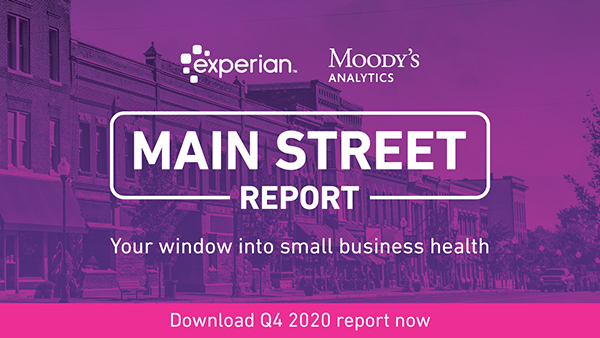
Experian and Moody's Analytics have just released the Q4 2020 Main Street Report. The report brings deep insight into the overall financial well-being of the small-business landscape and offers commentary on business credit trends and what they mean for lenders and small businesses. Small businesses increased hiring during the holiday season, offsetting some of the pandemic's job losses. Many of these jobs were funded by credit while companies paid down outstanding debt. This trend of paying down debt caused moderately delinquent balances to decline to 1.21 percent from 1.60 percent during the same time last year. There has yet to be a decisive upturn in delinquency and bankruptcy, as would be expected following the pandemic lockdowns of the previous year. With a change in administration, small businesses are feeling concerned about taxes, as noted in recent NFIB surveys. But these growing concerns did not dampen borrowing or hiring during the fourth quarter. Business Chat Live Watch the replay of our interview with Cristian DeRitis from Moody's Analytics and Brodie Oldham. Join us for the Q4 Quarterly Business Credit Review You can also save your seat for our upcoming Quarterly Business Credit Review webinar for a deep dive on the latest report. Date: Tuesday, March 16th, 2021 Time: 10 a.m. (Pacific) | 1:00 p.m. (Eastern) Save My Seat

New Experian Report: Beyond the Trends Experian Business Information Services is excited to present our new quarterly report "Beyond the Trends." In this report, we'll be evaluating challenges to particular industries. We'll be looking at account management, pre-treatment, and treatment strategies for small businesses coming out of COVID. The Winter edition has just been released, download your copy below. . Download Report
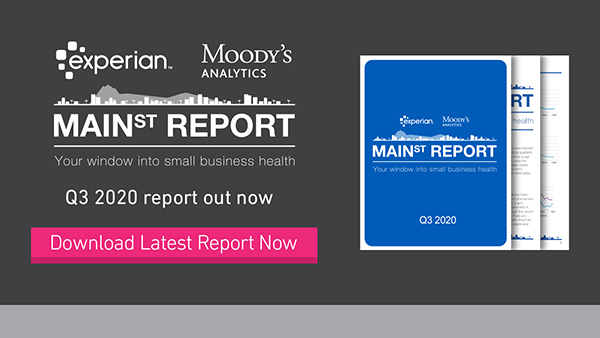
Experian and Moody's Analytics have just released the Q3 2020 Main Street Report. The report brings deep insight into the overall financial well-being of the small-business landscape, as well as offer... Experian and Moody's Analytics have just released the Q3 2020 Main Street Report. The report brings deep insight into the overall financial well-being of the small-business landscape, as well as offer commentary on business credit trends and what they mean for lenders and small businesses. In a fight for survival, small businesses have turned to layoffs and borrowing as they attempt to reach the other side of COVID-19. The increased borrowing is helping to mask rising late-stage delinquencies and bankruptcy. But these tactics can only mask weakness for so long. With another round of government stimulus unlikely to arrive before year's end, small businesses will need to borrow for survival again. While we did see some jobs come back in Q3, small business payrolls have shrunk by more than 2 million from this time last year. The hardest hit are those businesses with 1-19 and 20-49 employees; both of these groups saw payrolls shrink by 1 million employees. The 31-90 days past due (DPD) delinquency rate on small business credit plunged to 1.25 percent in the third quarter. This ended the streak of increasing delinquency we had observed for the last year. However, this is likely to be short-lived, as the US appears to have entered a new phase of the COVID-19 pandemic with cases again on the rise. Commercial and Industrial loans continued to run hot. C&I numbers are a lagging indicator, so the latest numbers reflect the second quarter. At that time new C&I lending was 21 percent higher than in the same period a year ago. If you would like to get the full analysis of the data behind the latest Main Street Report, join us for the Quarterly Business Credit Review webinar.
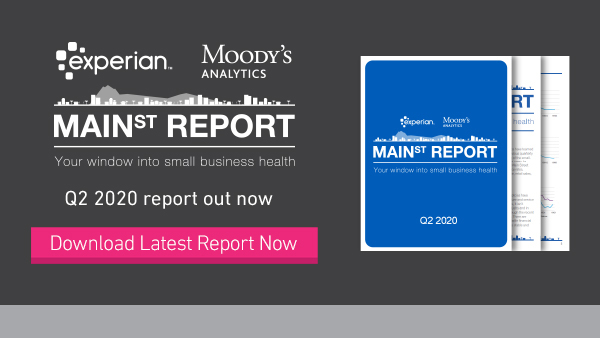
Experian and Moody's Analytics have just released the Q2 2020 Main Street Report. The report brings deep insight into the overall financial well-being of the small-business landscape, as well as offer commentary on business credit trends, and what they mean for lenders and small-businesses. Small businesses have turned to borrowing to survive periods of prolonged slumping sales, in many cases from government programs offering loan forgiveness. This increased borrowing has masked rising delinquent balances, but such a solution is a short-term fix. To keep their credit current, small businesses will need to find ways to generate revenue. Defaults are expected to rise in coming quarters as forbearance programs expire and as customers are likely to change their priorities in the wake of COVID-19. In Q2, moderate delinquency, defined as 31-90 days past due, rose to 1.66 percent from 1.61 percent, marking the fourth consecutive quarter of increasing delinquency, and the first year-over-year increase since this time last year. The closure of many state and local economies in April and the first half of May left many businesses facing severe revenue shortfalls in the second quarter. This environment has resulted in businesses listing poor sales as the second most important problem facing small businesses, according to the NFIB. If you would like to get the full analysis of the data behind the latest Main Street Report, presented by leading economists from Moody's Analytics and Experian, watch the Quarterly Business Credit Review webinar.
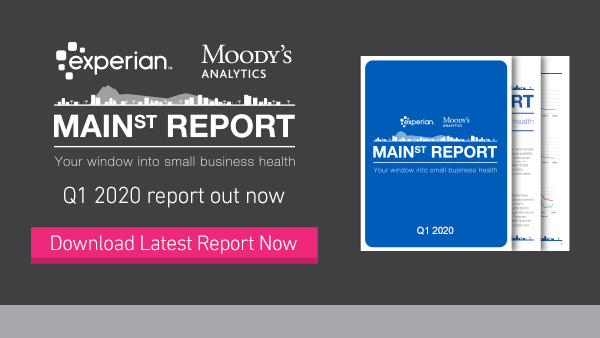
Experian and Moody's Analytics have just released the Q1 2020 Main Street Report. The report brings deep insight into the overall financial well-being of the small-business landscape, as well as offer commentary on business credit trends, and what they mean for lenders and small-businesses. After just one quarter, there’s no doubt the theme of 2020 is the pandemic, Covid-19. Unrelated to the pandemic, and subsequent shuttering of a swath of economies across the world, delinquencies rose in the first quarter. This was occurring as businesses reduced their borrowing. Lower borrowing will not have lasted long though, as government efforts to aid small business have taken the form of SBA lending. In Q1, the slowing of businesses pursuing credit pushed moderately delinquent balances up to 1.61 percent from 1.60 percent in the fourth quarter of 2019. # DPD Q1 19 Q4 19 Q1 20 Moderately delinquent 31–90 1.74% 1.60% 1.61% Severely delinquent 91+ 3.35% 2.29% 2.68% Bankruptcy 0.16% 0.16% 0.16% The bankruptcy rate was essentially flat in the first quarter, rising to 16.3 basis points from 16.1 in Q4. But the rate increased as fewer firms were reported as having active credit balances. The Federal Reserve’s Senior Loan Officer Survey indicates lenders are seeing higher demand than usual for Commercial & Industrial loans. This indicates the beginning of increasing loan demand this year, as small firms look to borrow to ride out lower consumer demand and remain in business. Watch the Quarterly Business Credit Review Get the full analysis of the data behind the Main Street Report by watching the experts from Experian and Moody’s in the Quarterly Business Credit Review.
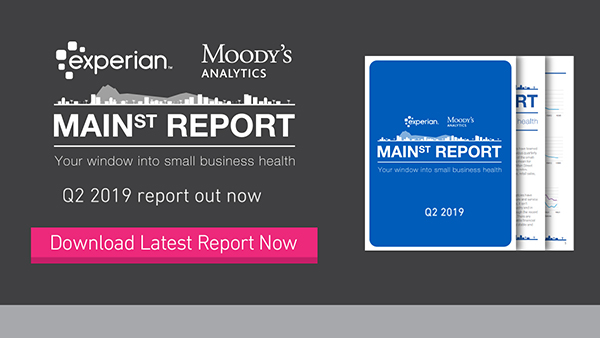
Experian and Moody’s Analytics have just released the Q2 2019 Main Street Report. The report brings deep insight into the overall financial well-being of the small-business landscape, as well as providing commentary on what certain trends mean for lenders and small businesses. Q2 Highlights In spite of business confidence in the second quarter, shaken by talk of trade war escalation, small businesses got a helping hand from seasonal factors that combined to push delinquency rates down. Delinquency rates for businesses with fewer than 100 employees fell in the second quarter, decreasing the 31–90 days past due rate from 1.74 percent to 1.64 percent for the quarter. But agriculture’s problems continued as weather and trade conditions continued to weigh on small farms. These factors won’t be as helpful in the third quarter, so fundamentals or confidence will need to improve to propel performance and growth forward. Bankruptcies ticked up ever so slightly again in the second quarter coming in at over 16 basis points. The most recent data available, from Q4 2018, indicates an establishment growth rate of 2.3%. Enough of these new businesses will seek credit to ensure that, combined with existing borrowers, balances look set to grow for some time. Overall, small businesses continue to display little to no signs of broad-based weakness. What weakness exists is fairly well confined at either the regional or industry level, and the solid performance that has been the norm for the last several quarters looks set to continue. Watch Webinar Recording Experian and Moody's Analytics go in-depth on the Q2 2019 Main Street Report in the below webinar.
